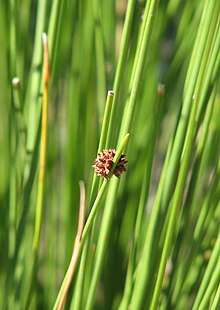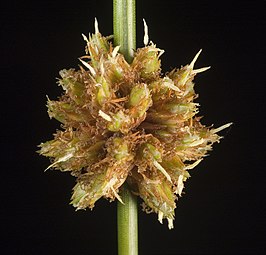
The Cyperaceae are a family of graminoid (grass-like), monocotyledonous flowering plants known as sedges. The family is large, with some 5,500 known species described in about 90 genera, the largest being the "true sedges" genus Carex with over 2,000 species.

Cyperus is a large genus of about 700 species of sedges, distributed throughout all continents in both tropical and temperate regions.

Ficinia spiralis is a coastal sedge endemic to New Zealand. Originally widespread, it has suffered severely from competition with introduced marram grass and animal grazing and now has only a patchy distribution.

Scirpus is a genus of grass-like species in the sedge family Cyperaceae many with the common names club-rush, wood club-rush or bulrush. They mostly inhabit wetlands and damp locations.
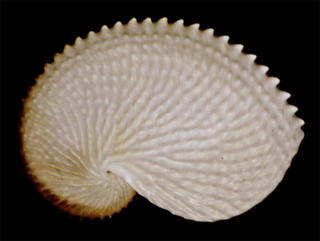
Argonauta nodosus [previously known as Argonauta nodosa], also known as the knobby or knobbed argonaut, is a species of pelagic octopus. The female of the species, like all argonauts, creates a paper-thin eggcase that coils around the octopus much like the way a nautilus lives in its shell. The shell is usually approximately 150 mm in length, although it can exceed 250 mm in exceptional specimens; the world record size is 292.0 mm. A. nodosus produces a very characteristic shell, which is covered in many small nodules on the ridges across the shell, hence the specific epithet nodosus and common name. These nodules are less obvious or even absent in juvenile females, especially those under 5 cm in length. All other argonaut species have smooth ridges across the shell walls.

Ammophila arenaria is a species of grass in the family Poaceae. It is known by the common names marram grass and European beachgrass. It is one of two species of the genus Ammophila. It is native to the coastlines of Europe and North Africa where it grows in the sands of beach dunes. It is a perennial grass forming stiff, hardy clumps of erect stems up to 1.2 metres (3.9 ft) in height. It grows from a network of thick rhizomes which give it a sturdy anchor in its sand substrate and allow it to spread upward as sand accumulates. These rhizomes can grow laterally by 2 metres in six months. One clump can produce 100 new shoots annually.

Kyllinga is genus of flowering plants in the sedge family known commonly as spikesedges. They are native to tropical and warm temperate areas of the world, especially tropical Africa. These sedges vary in morphology, growing to heights from 2.5 centimeters to a meter and sometimes lacking rhizomes. They are closely related to Cyperus species and sometimes treated as part of a more broadly circumscribed Cyperus.

Ficinia is a genus of tufted or rhizomatous sedges in the family Cyperaceae. There are around 70 recognised species in Africa, four species that occur in New Zealand and a single species Ficinia nodosa that occurs in Australia.

Scirpus cyperinus, commonly known as woolgrass, is an emergent wetland herb that is native to the eastern United States and eastern Canada. Other common names include cottongrass bulrush and brown woolly sedge.

Schoenoplectus pungens is a species of flowering plant in the sedge family known as common threesquare, common three-square bulrush and sharp club-rush. It is a herbaceous emergent plant that is widespread across much of North and South America as well as Europe, New Zealand and Australia.
Wīwī is a common name for several species of New Zealand rushes and sedges whose individual plants grow as a clump with wire-like stems. The name wīwī has been adopted in English from the Māori language.

Hudsonia tomentosa is a species of flowering plant in the rockrose family known by the common names woolly beachheather, beach heather, and sand heather. It is native to northeastern North America, including central and eastern Canada and the northeastern United States.
The Federation Walk Coastal Reserve is a reserve comprising the eastern part of The Spit on the Gold Coast, Queensland, Australia. The reserve was opened on 22 June 2003, and is approximately 93 hectares in size. The area supports a subtle mix of habitats including littoral rainforest, native grasslands, and pockets of wetlands. The Federation Walk track goes throughout the reserve.

Isolepis prolifera is a species of flowering plant in the family Cyperaceae that grows in temperate regions of the Southern Hemisphere. It has leafless stems up to 90 cm (35 in) tall, and clusters of flowers that often proliferate into branches.

Machaerina juncea, commonly known as bare twig-rush or tussock swamp twig rush, is a sedge in the sedge family, Cyperaceae, that is native to Australia, New Zealand, and New Caledonia.

Bolboschoenus caldwellii, commonly known as marsh club rush, is a flowering plant in the sedge family, Cyperaceae, that is native to Australia and New Zealand.

Carex pumila, commonly known as strand sedge or spreading sedge, is a species of sedge of the family Cyperaceae.

Cyperus pygmaeus, also known as dwarf flat sedge, is a sedge of the family Cyperaceae that is native to Australia.
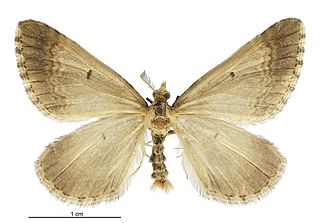
Asaphodes frivola, also known as the remuremu looper moth or Foveaux looper moth, is a species of moth in the family Geometridae with flightless females. It is endemic to New Zealand, and critically endangered, occurring in a very narrow and specialised habitat at just two small coastal sites near Invercargill.
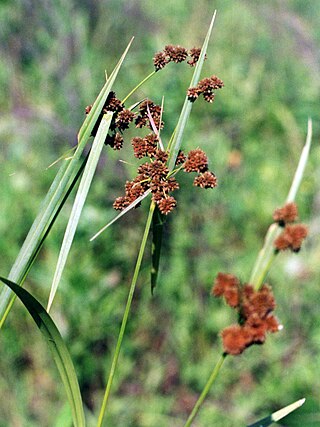
Scirpus atrovirens, known as dark-green bulrush, is a perennial sedge native to wetlands of eastern Canada and the United States. It is sometimes called dark green bulsedge, black bulrush, or green bulrush.
